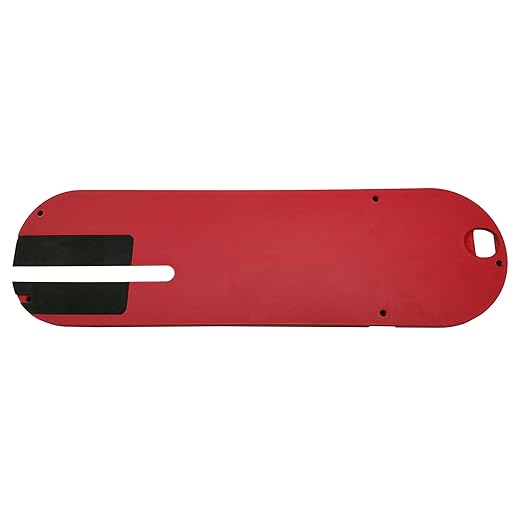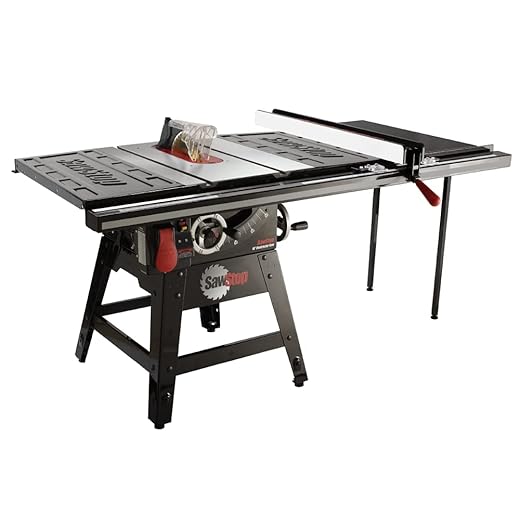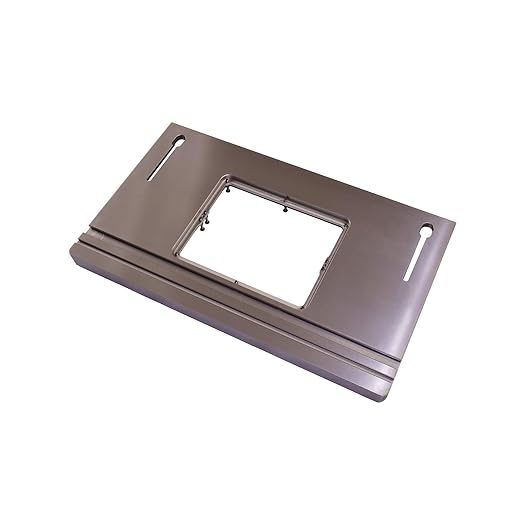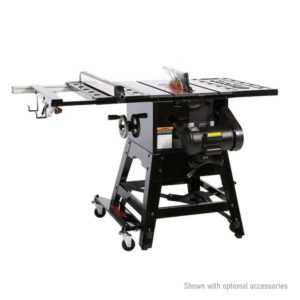The SawStop Contractor Saw is a versatile and reliable table saw designed for contractors, serious hobbyists, and woodworking enthusiasts. It combines high-performance cutting capabilities with advanced safety features to deliver a powerful and secure woodworking experience.
The Contractor Saw features the innovative SawStop safety system, which can detect contact with flesh and stop the blade within milliseconds, greatly reducing the risk of severe injuries. This safety feature offers peace of mind and an added layer of protection during woodworking operations.
In terms of performance, the Contractor Saw is equipped with a powerful motor that provides ample cutting power for various woodworking tasks. Its robust construction and sturdy build quality ensure durability and stability even during demanding cutting operations. The saw also offers a generous cutting capacity, allowing for precision cuts on a range of materials.
Additionally, the Contractor Saw incorporates features that enhance user convenience and ease of use. It has a reliable fence system, a miter gauge for accurate angled cuts, and easy-to-use controls for blade height and angle adjustments. Dust collection ports are available to help maintain a cleaner workspace.
The Contractor Saw is designed to be portable and adaptable, making it suitable for job sites, small workshops, or spaces with limited room. It strikes a balance between power, versatility, and mobility, catering to the needs of professionals and serious woodworkers who require a reliable and safe table saw for their projects.
Overall, the SawStop Contractor Saw offers a blend of performance, safety, and portability, making it a dependable tool for contractors and woodworking enthusiasts seeking high-quality results in a range of woodworking applications.
Can you do everything with a SawStop contractor saw?
While the SawStop Contractor Saw is a versatile and capable table saw, there may be some limitations to what it can accomplish depending on the specific woodworking tasks or projects. Here are a few considerations:
- Cutting Capacity: The cutting capacity of the SawStop Contractor Saw may have limitations compared to larger and more powerful saws. It typically has a smaller table size and may have a lower maximum depth and width of cut. This may affect its ability to handle larger or thicker stock. However, within its cutting capacity, it can perform a wide range of woodworking tasks.
- Intensity of Use: The SawStop Contractor Saw is designed for regular use, but it may have limitations when it comes to heavy-duty or continuous use. If you frequently undertake demanding cutting tasks or work on larger projects that require long periods of operation, a more powerful and robust saw like a cabinet saw may be more suitable.
- Specialized Applications: Some specialized woodworking applications may require specific features or capabilities that the Contractor Saw may not provide. For example, if you primarily work with intricate joinery, highly detailed cuts, or extremely thick and dense hardwoods, a saw with advanced features or greater power may be more appropriate.
- Industrial or Production-level Work: If you are engaged in industrial-scale production or require a table saw for heavy commercial use, a contractor saw may not have the capacity, durability, or speed required for such demanding applications. In such cases, higher-end industrial-grade table saws or specialized saws may be more suitable.
However, it’s important to note that for the majority of woodworking tasks and projects, the SawStop Contractor Saw is capable of delivering excellent performance, precision cuts, and enhanced safety. It is a versatile tool that can handle a wide range of woodworking applications, making it suitable for contractors, serious hobbyists, and many DIY projects.
What is a contractor table saw used for?
The SawStop Contractor Saw is a versatile and powerful table saw designed for a wide range of woodworking applications. It is used for various cutting tasks, precision woodworking, and construction projects. Here are some common uses for the SawStop Contractor Saw:
- Precision Woodworking: The Contractor Saw is suitable for precision woodworking tasks that require accurate and clean cuts. It can handle cutting boards, creating joinery, crafting furniture components, and other woodworking projects that demand high precision.
- Job Sites and Construction: Due to its portability and durability, the Contractor Saw is commonly used on job sites and construction projects. It can handle a variety of cutting tasks, including framing, rough cuts, and finishing work. Its ability to be easily transported and set up makes it convenient for contractors and construction professionals.
- Cabinet Making: The Contractor Saw is well-suited for cabinet making projects. It can cut sheet goods like plywood and particleboard accurately, allowing for the construction of cabinet boxes, doors, shelves, and other components.
- Furniture Making: Woodworkers engaged in furniture making will find the Contractor Saw useful for cutting various types of wood, including hardwoods and softwoods. It can handle precise cuts for creating furniture pieces like tables, chairs, cabinets, and more.
- DIY and Home Projects: The Contractor Saw is also popular among DIY enthusiasts and hobbyists working on woodworking projects at home. It can tackle a range of DIY projects such as building shelves, crafting home decor items, making small furniture pieces, and other woodworking tasks.
The versatility and power of the SawStop Contractor Saw make it suitable for professional contractors, serious woodworking hobbyists, and DIY enthusiasts alike. Whether you’re working on job sites, constructing furniture, or engaging in home projects, the Contractor Saw provides the performance, accuracy, and safety features necessary for efficient and high-quality woodworking.
What is the difference between a contractor saw and a cabinet saw?
The main differences between a contractor saw and a cabinet saw lie in their design, construction, and intended usage. Here are the key distinctions:
- Design and Construction: Contractor saws are typically designed to be portable and lightweight compared to cabinet saws. They are built with a smaller footprint, making them more suitable for job sites and spaces with limited room. Cabinet saws, on the other hand, have a heavier and sturdier construction with a larger table and a more robust base. They are intended for stationary use in dedicated workshops.
- Mobility: Contractor saws are designed with portability in mind. They often feature wheels or a folding stand, allowing for easier transport and mobility between job sites. Cabinet saws, being heavier and more stationary, are typically installed in a fixed location in a workshop and are less mobile.
- Power and Performance: Cabinet saws are generally more powerful than contractor saws. They often have larger motors, more robust construction, and better vibration damping, which results in smoother and more consistent cuts. Cabinet saws are capable of handling heavy-duty cutting tasks and thicker materials with ease. Contractor saws, while still powerful, are typically more compact and may have slightly less cutting capacity.
- Dust Collection: Cabinet saws often come with more advanced dust collection systems. They may have better dust collection capabilities and built-in features to improve dust management, such as dust ports and shrouds. Contractor saws may have more basic dust collection systems or require additional accessories to improve dust extraction.
- Price: Cabinet saws are generally more expensive than contractor saws due to their heavier construction, increased power, and higher-end features. Contractor saws are designed to be more budget-friendly options that still offer decent performance and portability.
Overall, cabinet saws are favored by professional woodworkers, dedicated hobbyists, or those with larger workshop spaces, as they offer superior power, stability, and precision. Contractor saws, on the other hand, are popular among contractors, job site workers, and DIY enthusiasts who prioritize portability without compromising on cutting performance. The choice between a contractor saw and a cabinet saw depends on your specific needs, budget, available space, and intended usage.
What materials Cannot be cut on sawstop contractor saw?
The SawStop Contractor Saw, like other table saws, is primarily designed for cutting wood and wood-based materials. While it can handle a wide range of materials commonly used in woodworking, there are certain materials that are not suitable for cutting on a table saw, including the SawStop Contractor Saw. Here are some examples of materials you should avoid cutting:
- Non-Conductive Materials: The SawStop safety system relies on the detection of electrical capacitance changes to trigger the braking mechanism. Therefore, materials that are non-conductive or have very low conductivity may not be recognized by the system. Examples of such materials include plastics, glass, stone, ceramics, and non-ferrous metals like aluminum or copper.
- Wet or Damp Materials: Cutting wet or damp materials, regardless of their conductivity, is generally not recommended on any table saw, including the SawStop Contractor Saw. Wet wood or other materials can affect the performance of the blade, increase the risk of kickback, and potentially compromise safety.
- Excessively Thick or Hard Materials: The SawStop Contractor Saw is designed for cutting wood and wood-based materials of typical thicknesses encountered in woodworking projects. Excessively thick or extremely hard materials, such as dense hardwoods or metals, may put excessive strain on the saw’s motor, blade, and braking mechanism, potentially leading to reduced performance or damage.
- Hazardous Materials: It is important to note that certain materials may be hazardous to cut on any table saw, including those with the SawStop safety system. These materials include but are not limited to materials that contain toxic chemicals, asbestos, or other harmful substances. Cutting such materials can pose health risks and may damage the saw.
It’s essential to refer to the manufacturer’s guidelines and recommendations provided with your specific SawStop Contractor Saw to determine the appropriate materials for cutting. If you have specific materials or projects in mind that deviate from typical woodworking applications, it’s advisable to consult the manufacturer or seek professional advice to ensure safe and appropriate usage.
What are the benefits of a SawStop Contractor Saw?
The SawStop Contractor Saw offers several benefits that make it a popular choice among woodworking enthusiasts and contractors. Here are some of the key benefits of the SawStop Contractor Saw:
- Enhanced Safety: One of the standout features of the SawStop Contractor Saw is its advanced safety system. The SawStop safety technology can detect contact with flesh and stop the blade within milliseconds, minimizing the risk of severe injuries. This added safety measure provides peace of mind during woodworking operations and helps create a safer working environment.
- Portability: The Contractor Saw is designed with portability in mind. It features a compact size and often comes with wheels or a folding stand, allowing for easier transportation and mobility between job sites or within a workshop. This portability makes it a convenient option for contractors or woodworkers who require a saw that can be easily moved and set up in different locations.
- Versatility: The Contractor Saw is versatile and can handle a wide range of woodworking tasks. It is suitable for precision woodworking, cabinetry, furniture making, and DIY projects. Its cutting capacity allows for various wood sizes and thicknesses, providing flexibility for different projects.
- Durability and Construction: The Contractor Saw is built to withstand job site conditions and regular use. It typically features a robust construction with quality materials, ensuring durability and stability during cutting operations. This durability helps the saw withstand the demands of contractor work and frequent transportation.
- Cutting Performance: The Contractor Saw offers reliable cutting performance. It is equipped with a powerful motor that delivers ample cutting power for various woodworking tasks. The saw’s design and features, such as the fence system and miter gauge, contribute to precise and accurate cuts.
- Value for Money: The Contractor Saw provides a balance between performance, features, and affordability. It is often more budget-friendly compared to higher-end cabinet saws while still delivering reliable cutting performance and safety features. This makes it a cost-effective choice for contractors, serious hobbyists, or woodworkers looking for a dependable table saw.
Overall, the SawStop Contractor Saw combines safety, portability, versatility, and durability, making it a reliable tool for woodworking projects. Its advanced safety system, combined with its other features, offers a compelling package for those seeking a high-quality table saw for various applications.
Factors to consider when buying sawstop contractor saw?
When buying a SawStop Contractor Saw, there are several factors to consider to ensure that you choose the right model that meets your woodworking needs and preferences. Here are some key factors to keep in mind:
- Safety Features: SawStop Contractor Saws are known for their advanced safety features. Consider the specific safety features offered by the model you are considering, such as the SawStop safety system, blade guards, emergency stop buttons, and other safety mechanisms. Prioritize safety features that align with your needs and provide the level of protection you desire.
- Power and Performance: Evaluate the power of the motor and the overall cutting performance of the saw. Consider the types of materials you work with and the cutting tasks you regularly perform. Ensure that the motor power and cutting capacity of the Contractor Saw are sufficient for your woodworking projects and requirements.
- Cutting Capacity: Assess the cutting capacity of the Contractor Saw, including the maximum depth and width of materials it can handle. Consider the sizes of the stock you typically work with and ensure that the saw’s cutting capacity meets your needs. Keep in mind that larger and thicker materials may require a saw with greater cutting capacity.
- Build Quality and Durability: Examine the build quality and durability of the Contractor Saw. Look for sturdy construction, quality materials, and components that can withstand regular use and potentially harsh job site conditions. A robustly built saw will provide longevity and stability during cutting operations.
- Portability and Workspace: Consider the portability of the Contractor Saw and whether it suits your needs. Evaluate its weight, dimensions, and features like wheels or a folding stand for ease of transportation and mobility. Additionally, assess the available space in your workshop or job site to ensure the saw fits comfortably.
- Price and Budget: Determine your budget range and explore the SawStop Contractor Saw models within that range. Compare prices and features to find the best balance between your budget and the features and capabilities you require. Consider the value of the enhanced safety features and performance offered by the SawStop brand.
- User Reviews and Feedback: Read user reviews and seek feedback from other woodworkers who have experience with the specific SawStop Contractor Saw model you are considering. Real-world experiences can provide valuable insights into the performance, reliability, and overall satisfaction with the saw.
By considering these factors, you can make an informed decision and select the SawStop Contractor Saw that best meets your safety requirements, cutting needs, budget, and workspace considerations.
How long does sawstop contractor saw last?
The lifespan of a SawStop Contractor Saw can vary depending on various factors, including frequency of use, maintenance, and the specific model. However, with proper care and regular maintenance, a well-maintained SawStop Contractor Saw can last for many years of reliable service.
The durability and longevity of the saw depend on several factors:
- Build Quality: SawStop is known for producing high-quality table saws. The materials used, construction methods, and overall build quality contribute to the durability and longevity of the saw. The Contractor Saw is designed to withstand regular use, job site conditions, and transportation.
- Maintenance: Regular maintenance is essential for extending the lifespan of any power tool, including the SawStop Contractor Saw. This includes proper cleaning, lubrication of moving parts, alignment checks, and replacing worn-out components when necessary. Following the manufacturer’s maintenance guidelines and recommendations will help ensure optimal performance and longevity.
- Intensity of Use: The frequency and intensity of use can affect the lifespan of any power tool. The Contractor Saw is designed for regular use, including job site and workshop applications. However, intense and continuous use may put more strain on the saw and its components, potentially affecting its lifespan.
- Replacement Parts Availability: The availability of replacement parts is also a factor to consider. Over time, certain components may wear out and require replacement. SawStop’s commitment to customer support and their network of authorized service centers ensures that replacement parts are readily available for their table saws, including the Contractor Saw.
While specific guarantees or warranties may be provided by the manufacturer, the actual lifespan of a SawStop Contractor Saw can vary based on the factors mentioned above. With proper care, maintenance, and responsible usage, a well-maintained SawStop Contractor Saw can provide many years of reliable and safe woodworking.
Do you really need sawstop contractor saw?
Whether or not you need a SawStop Contractor Saw depends on your specific woodworking needs, priorities, and circumstances. Here are some factors to consider when determining if the SawStop Contractor Saw is right for you:
- Safety Priority: If safety is a top concern for you, the SawStop Contractor Saw can offer enhanced safety features through its SawStop safety system. This system can detect contact with flesh and stop the blade within milliseconds, potentially preventing severe injuries. If safety is a paramount consideration in your woodworking activities, the SawStop Contractor Saw may be worth considering.
- Professional or Job Site Use: If you are a professional contractor or frequently work on job sites, the portability and durability of the Contractor Saw can be advantageous. Its compact size, built-in mobility features, and ability to withstand job site conditions make it a practical choice for those who require a portable table saw.
- Cutting Capacity: Consider the size and thickness of the materials you typically work with. The Contractor Saw has a respectable cutting capacity, but if you frequently handle larger or thicker stock, you may require a table saw with greater cutting capacity, such as a cabinet saw.
- Budget: The SawStop Contractor Saw is generally more affordable compared to higher-end cabinet saws. If budget is a significant consideration and you still want the enhanced safety features of SawStop, the Contractor Saw can be a cost-effective option.
- Workspace and Portability: Evaluate your available workspace and mobility needs. The Contractor Saw’s smaller size and portability make it suitable for those with limited workshop space or the need to transport the saw between locations.
- Alternative Safety Measures: It’s important to note that there are other safety measures you can implement on a conventional table saw to reduce the risk of accidents, such as using blade guards, push sticks, and practicing safe cutting techniques. While these measures do not provide the same level of automatic blade-stopping capability as SawStop, they can contribute to a safer working environment.
Ultimately, the decision to purchase a SawStop Contractor Saw should be based on your individual needs, safety priorities, budget, available space, and intended usage. Carefully weigh the advantages and disadvantages, and consider alternatives to determine if the SawStop Contractor Saw aligns with your woodworking requirements.
You May Also Like These Deals!
What is sawstop contractor saw?
The SawStop Contractor Saw is a versatile and reliable table...
Read MoreWhat is sawstop compact table saw used for?
The SawStop Compact Table Saw is a smaller, portable version...
Read MoreHow does sawstop table saw work?
SawStop table saws are renowned for their innovative safety features...
Read MoreIs a SawStop worth the price?
SawStop is a pioneering technology in the field of power...
Read MoreProducts recommended in the post contain affiliate links. We may receive a commission when you buy something through our posts.
Why Trust Us
You will find what you are looking for at Black Friday Weeks. From classic to luxury brands, you'll find both. We will help you to select appliances that fit your needs, budget and lifestyle. Whether you want to stop by to learn more — or plan to make a major purchase — we’ll treat you like family and assist you every step of the way. Shop with us today to receive friendly and experienced help along the way.















